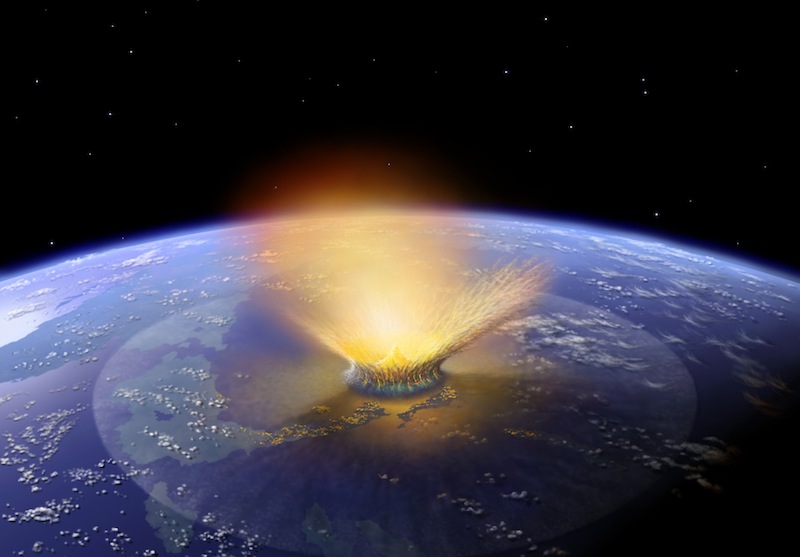Life May Be Common in the Milky Way, Thanks to Comet Swapping

Life has had plenty of opportunities to spread throughout the Milky Way galaxy over the eons, a recent study suggests — and our own Earth may be one of the key dispersal points.
The sun's random motion through space has brought it close to many other stars over the past 4.6 billion years. These close encounters likely jostle far-flung comets free from both systems, sending them careening toward the passing star, said study author Robert Zubrin, president of the Colorado-based company Pioneer Astronautics.
This "comet swapping" is probably responsible for many of Earth's past mass extinctions, Zubrin found. But the phenomenon has also likely aided life in the bigger picture, helping it hop from island to island across the vast ocean of space, he said.
Related: 7 Theories on the Origin of Life
"It's a mechanism whereby life could have been delivered to us, and whereby we have probably delivered life to lots of other places over the past 3.5 billion years," Zubrin told Space.com. "And if you simply extrapolate off of that and say, 'Everybody's doing this,' you've got the galaxy as a supercritical reactor, saturating itself with life."
This conclusion is based on some straightforward calculations, which take into account the average stellar density in the sun's neighborhood (0.003 stars per cubic light-year), the sun's velocity relative to this star field (about 22,370 mph, or 36,000 km/h) and the makeup of the Milky Way's stellar population (about 75% small, dim red dwarfs, for example).
Zubrin also assumed that other stars harbor huge comet repositories on their outskirts, like our own sun's Oort Cloud. The extent of the Oort Cloud is unknown; its outer edge is estimated to lie anywhere between 30,000 and 100,000 astronomical units (AU) from the sun. (1 AU is the average Earth-sun distance — about 93 million miles, or 150 million kilometers.)
Breaking space news, the latest updates on rocket launches, skywatching events and more!
Zubrin employed a relatively conservative size estimate, setting our Oort Cloud's radius at 40,000 AU. He then used that figure to estimate the average radii of other star types' Oort Clouds. Red dwarfs, for example, should be able to hold onto comets out to about 20,000 AU, he determined.
It's unclear how many comets lie in the Oort Cloud. Zubrin assumed a population of 1 trillion — an estimate that's thrown around frequently — and therefore arrived at a density of four comets per 1,000 cubic AU.
The sun can gravitationally capture another star's Oort Cloud object if it gets within 10 AU of that object, Zubrin determined. So, there could be a lot of captures per stellar encounter. For example, say the sun gets within 20,000 AU of another star. The sun would carve a roughly 20,000-AU path through that alien Oort Cloud, potentially capturing 25,000 objects (assuming alien Oort Clouds also harbor about four objects per 1,000 cubic AU.)
These captured bodies would come barreling toward the inner solar system, drawn by the sun's powerful gravitational tug. And some of our Oort Cloud objects would do the same, in the other direction.
Related: 10 Exoplanets That Could Host Alien Life
"The great majority of impacts caused by disrupted objects would no doubt be delivered to gas-giants type planets," Zubrin wrote in the study, which was published in June in the International Journal of Astrobiology. "However, with such a large number of objects released per pass, Earth-sized worlds would likely be impacted as well."
The numbers are different for stars of different sizes, because they have stronger or weaker gravitational pulls depending on their masses. A red dwarf with 30% the mass of the sun, for example, would have to get within 3 AU of another star's Oort Cloud object to snag it, Zubrin found.
He used all of this information (and more) to calculate the frequency of close stellar encounters, and to get a handle on their consequences. And the results were striking, if you'll pardon the pun.
He found that our sun has had about 47 close stellar encounters per billion years over the course of its 4.6-billion-year life, with about half of those flybys involving red dwarfs. That works out to about one encounter every 21 million years.
This latter figure is intriguingly close to the inferred periodicity of mass extinctions here on Earth, which seem to occur every 20 million to 40 million years. Scientists have proposed that comet impacts are dealing these death blows, and have therefore come up with possible mechanisms that could send these icy wanderers screaming toward Earth at regular intervals.
For example, some researchers have posited that the sun has an undiscovered companion, dubbed Nemesis, which jostles our Oort Cloud every 26 million years or so. Others think this destabilization comes courtesy of a disk of galactic dark matter, which our solar system travels through on a similar timescale.
But Zubrin's work fingers alien comets, not those native to our own solar system, as the primary agents of destruction.
His calculations also suggest that solar systems frequently trade material via such comet bombardments. For example, dust blasted off Earth by impacts can be pushed outward by sunlight pressure at 67,000 mph (108,000 km/h), Zubrin wrote — considerably faster than two stars are moving relative to each other in a typical close encounter.
That means microbes could make the jump from our system to a temporary neighbor. And they could do so relatively quickly, avoiding extensive exposure to damaging deep-space radiation. (The idea that life has hopped from world to world, and perhaps even from solar system to solar system, is known as panspermia. There are multiple variants. For example, some scientists think Earth life was seeded intentionally by intelligent aliens — a concept known as directed panspermia.)
"Furthermore, even if ejected material fails to hit the passing solar system, it could become captured in the home solar system’s Oort Cloud," Zubrin wrote. "Such material, as well as dust particles containing microbes previously driven outward by the pressure of sunlight, could be stored for long periods in Oort Cloud objects in deep freeze under effective ice shielding until a subsequent encounter with a different passing stellar system causes it to be released and transferred at that time."
Our sun is more massive than 90% of the stars in the Milky Way, so our Oort Cloud is more extensive than most. This means that we've been the dominant donor in most stellar encounters, delivering about three times more cometary bombardments on other solar systems than we ourselves receive, Zubrin said.
The overall implication of these results is exciting for astrobiologists, and anyone else who hopes Earth life isn't alone in the universe.
"The galaxy has been seeded with life, if from no other source than the Earth," Zubrin said.
- Could Life on Earth Have Come from Another Star System?
- Wipeout: History's Most Mysterious Extinctions
- For Close-Knit Planets, Sharing Life Could Be Easy
Mike Wall's book about the search for alien life, "Out There" (Grand Central Publishing, 2018; illustrated by Karl Tate), is out now. Follow him on Twitter @michaeldwall. Follow us on Twitter @Spacedotcom or Facebook.

Michael Wall is a Senior Space Writer with Space.com and joined the team in 2010. He primarily covers exoplanets, spaceflight and military space, but has been known to dabble in the space art beat. His book about the search for alien life, "Out There," was published on Nov. 13, 2018. Before becoming a science writer, Michael worked as a herpetologist and wildlife biologist. He has a Ph.D. in evolutionary biology from the University of Sydney, Australia, a bachelor's degree from the University of Arizona, and a graduate certificate in science writing from the University of California, Santa Cruz. To find out what his latest project is, you can follow Michael on Twitter.
